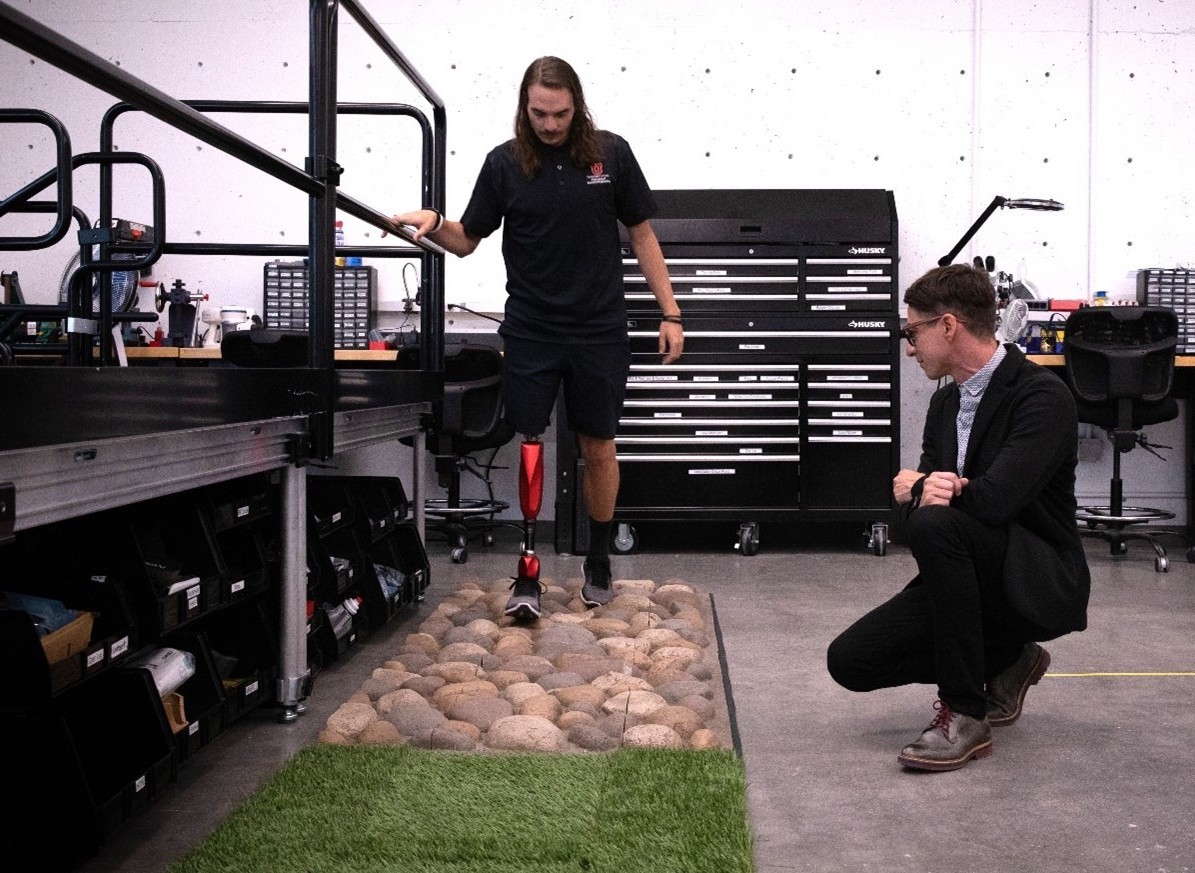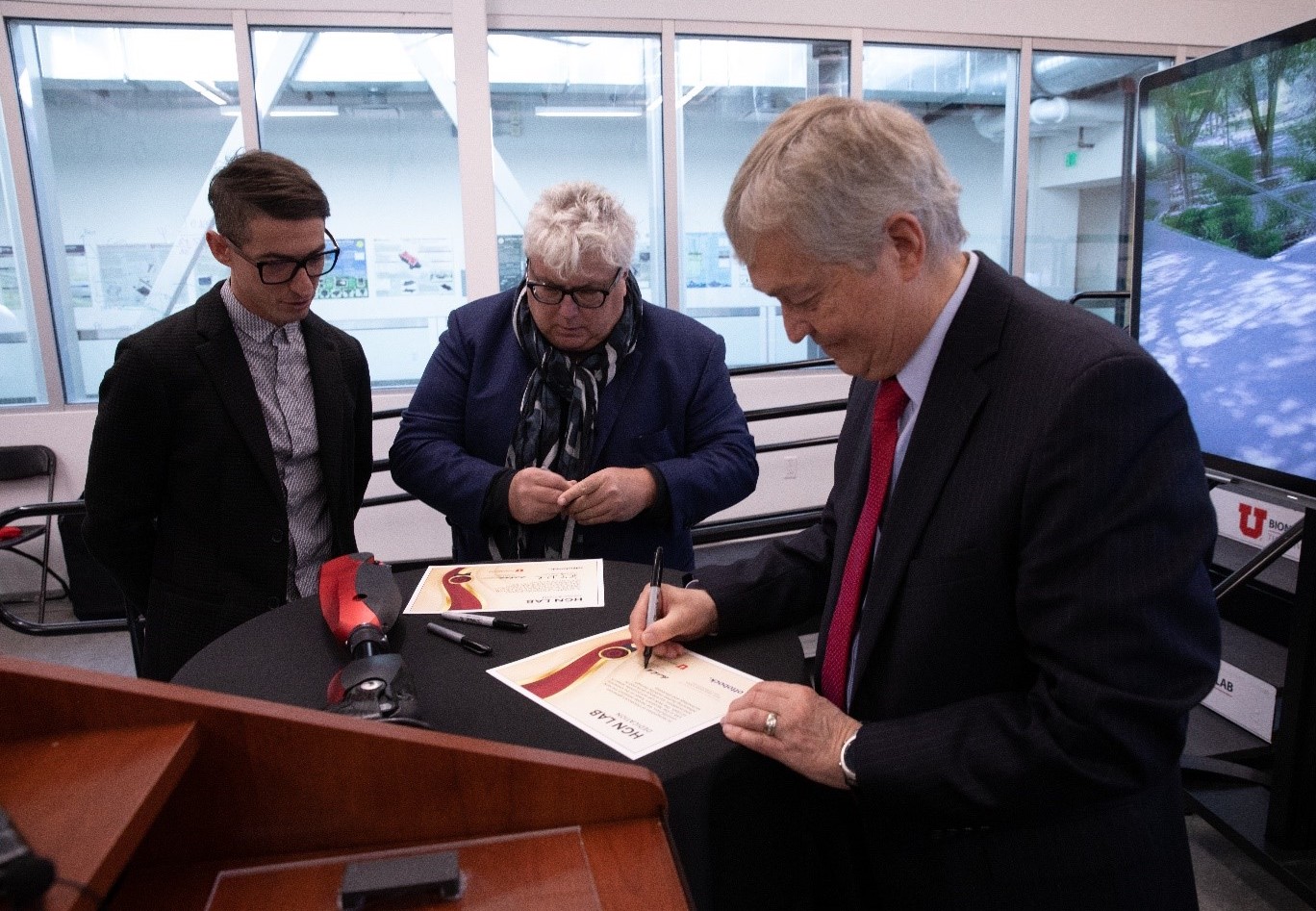Military Operational Medicine (JPC-5)
A Lightweight Powered Prosthetic Limb for Individuals with Above-Knee Amputations



Posted August 11, 2023
Tommaso Lenzi, Ph.D., University of Utah
Studies have shown that mobility significantly impacts quality of life for individuals using lower limb prosthetic devices.1 Multiple types of above-knee prostheses offer differing levels of assistance to the device wearer. Passive and microprocessor-controlled prostheses cannot actively move or generate positive power when walking, requiring the user to use the rest of their body to compensate for these limitations. Robotic, powered prostheses actively move the device while also providing valuable battery-powered assistance to the user. Although powered prosthetics can more closely reflect the movement and energy of biological legs, they are usually heavy and have short battery lives, which limits practical use.
With support from a fiscal year 2020 Defense Medical Research and Development Program Restoring Warfighters with Neuromusculoskeletal Injuries Research Award ‒ Research Level 2 ‒ Pilot Clinical Trial, Dr. Tommaso Lenzi's team aims to optimize and test their novel Utah Bionic Leg, a lightweight powered prosthesis for people with above-knee amputations. The team designed the joints to optimize the flow of energy through the bionic leg and mimic the action of biological joints. They have worked with individuals with above-knee amputations to test the device in multiple movement scenarios, including standing up and climbing stairs; users stood up faster and with better balance compared to passive prostheses and were able to ascend stairs step-over-step, and even navigate stairs of different heights.
The Utah Bionic Leg is anticipated to support up to 15,460 steps on a single battery charge, which is greater than the estimated 10,000 steps the average person without an amputation takes each day. The team also plans to include an optional passive mode, which will allow the user to walk on level surfaces without a charged battery, an attribute unique to this powered device. In an upcoming pilot clinical trial, subjects will test both the Utah Bionic Leg and a passive prosthesis for 30 days, comparing their experiences with each. Should the Utah Bionic Leg reach consumer use it has the potential to improve mobility and overall quality of life for people with above-knee amputations.
 Figure 2: Dr. Tommaso Lenzi, of the University of Utah, received a fiscal year 2020 Defense Medical Research and Development Program Restoring Warfighters with Neuromusculoskeletal Injuries Research Award ‒ Research Level 2 ‒ Pilot Clinical Trial from the Congressionally Directed Medical Research Programs' Military Operational Medicine Research Program to optimize and test their novel Utah Bionic Leg, a lightweight powered prosthesis for people with above-knee amputations. The above figure shows a subject wearing the Utah Bionic Leg walking on an uneven terrain simulator in the university's HGN Lab for Bionic Engineering.
Figure 2: Dr. Tommaso Lenzi, of the University of Utah, received a fiscal year 2020 Defense Medical Research and Development Program Restoring Warfighters with Neuromusculoskeletal Injuries Research Award ‒ Research Level 2 ‒ Pilot Clinical Trial from the Congressionally Directed Medical Research Programs' Military Operational Medicine Research Program to optimize and test their novel Utah Bionic Leg, a lightweight powered prosthesis for people with above-knee amputations. The above figure shows a subject wearing the Utah Bionic Leg walking on an uneven terrain simulator in the university's HGN Lab for Bionic Engineering.  Figure 1: Dr. Tommaso Lenzi, of the University of Utah, received a fiscal year 2020 Defense Medical Research and Development Program Restoring Warfighters with Neuromusculoskeletal Injuries Research Award ‒ Research Level 2 ‒ Pilot Clinical Trial from the Congressionally Directed Medical Research Programs' (CDMRP) Military Operational Medicine Research Program to optimize and test their novel Utah Bionic Leg, a lightweight powered prosthesis for people with above-knee amputations. The above figure shows the ceremonial signing of the licensing agreement between the University of Utah and the orthopedic technology firm Ottobock. From left to right: Dr. Tommaso Lenzi, inventor of the Utah Bionic Leg and Principal Investigator in the CDMRP award; Prof. Hans-Georg Nader, owner and chairman of Ottobock; and Dr. Rich Brown, Dean of the College of Engineering at the University of Utah.
Figure 1: Dr. Tommaso Lenzi, of the University of Utah, received a fiscal year 2020 Defense Medical Research and Development Program Restoring Warfighters with Neuromusculoskeletal Injuries Research Award ‒ Research Level 2 ‒ Pilot Clinical Trial from the Congressionally Directed Medical Research Programs' (CDMRP) Military Operational Medicine Research Program to optimize and test their novel Utah Bionic Leg, a lightweight powered prosthesis for people with above-knee amputations. The above figure shows the ceremonial signing of the licensing agreement between the University of Utah and the orthopedic technology firm Ottobock. From left to right: Dr. Tommaso Lenzi, inventor of the Utah Bionic Leg and Principal Investigator in the CDMRP award; Prof. Hans-Georg Nader, owner and chairman of Ottobock; and Dr. Rich Brown, Dean of the College of Engineering at the University of Utah. Reference:
1Wurdeman SR, Stevens PM and Campbell JH. 2018. Mobility analysis of AmpuTees (MAAT I): Quality of life and satisfaction are strongly related to mobility for patients with a lower limb prosthesis. Prosthetics and Orthotics International 42(5):498-503. https://doi.org/10.1177/0309364617736089
Publication:
1Tran M, Gabert L, Hood S, et al. 2022. A lightweight robotic leg prosthesis replicating the biomechanics of the knee, ankle, and toe joint. Science Robotics 7(72):eabo3996. https://doi.org/10.1126/scirobotics.abo3996
2Tran M, Gabert L, and Lenzi T. 2023. Analysis and validation of sensitivity in torque-sensitive actuators. Actuators 12(2):80. https://doi.org/10.3390/act12020080
3Hunt GR, Hood S, Gabert L, et al. 2023. Effect of increasing assistance from a powered prosthesis on weight-bearing symmetry, effort, and speed during stand-up in individuals with above-knee amputation. IEEE Transactions on Neural Systems and Rehabilitation Engineering: A Publication of the IEEE Engineering in Medicine and Biology Society e:11-21. https://doi.org/10.1109/TNSRE.2022.3214806
4Hunt GR, Hood S, Gabert L, et al. 2023. Can a powered knee-ankle prosthesis improve weight-bearing symmetry during stand-to-sit transitions in individuals with above-knee amputations? Journal of Neuroengineering and Rehabilitation 20(1):58. https://doi.org/10.1186/s12984-023-01177-w
5Hood S, Gabert L, and Lenzi T. 2022. Powered knee and ankle prosthesis with adaptive control enables climbing stairs with different stair heights, cadences, and gait patterns. IEEE Transactions on Robotics 38(3):1430-1441. doi: 10.1109/TRO.2022.3152134. Epub 2022 Mar 22. PMID: 35686286, PMCID: PMC9175645.
6Tran M, Gabert L, Hood S, et al. 2022. A lightweight robotic leg prosthesis replicating the biomechanics of the knee, ankle, and toe joint. Science Robotics 7(72):eabo3996. https://doi.org/10.1126/scirobotics.abo3996
Link:
Public and Technical Abstracts: Lightweight Powered Knee-Ankle Prosthesis for Community Ambulation
Last updated Thursday, March 27, 2025














